Refractive Indices of Biomass Burning Aerosols Obtained from African Biomass Fuels Using RDG Approximation
Abstract
1. Introduction
2. Experiment Method
3. Theoretical Method
Image Processing and Data Extraction from TEM Image
4. Results
4.1. Eucalyptus Fuel Combusted at 800 °C
4.2. Olive Fuel Combusted at 800 °C
5. Discussion
6. Conclusions
Supplementary Materials
Author Contributions
Funding
Acknowledgments
Conflicts of Interest
References
- Samset, B.H. Aerosols and Climate; Oxford University Press: Oxford, UK, 2016. [Google Scholar] [CrossRef]
- Mian, C.; Diehl, T.; Dubovik, O.; Eck, T.F.; Holben, B.N.; Sinyuk, A.; Streets, D.G. Light absorption by pollution, dust, and biomass burning aerosols: A global model study and evaluation with AERONET measurements. Ann. Geophys. 2009, 27, 3439–3464. [Google Scholar] [CrossRef]
- IPCC. Climate Change 2013: The Physical Science Basis. Contribution of Working Group I to the Fifth Assessment Report of the Intergovernmental Panel on Climate Change; Cambridge University Press: Cambridge, UK, 2013; p. 1535. [Google Scholar]
- Kirk-Davidoff, D. Chapter 3.4—The Greenhouse Effect, Aerosols, and Climate Change. In Green Chemistry; Török, B., Dransfield, T., Eds.; Elsevier: Amsterdam, The Netherlands, 2018; pp. 211–234. [Google Scholar]
- Fiore, A.M.; Naik, V.; Leibensperger, E.M. Air Quality and Climate Connections. J. Air Waste Manag. Assoc. 2015, 65, 645–685. [Google Scholar] [CrossRef] [PubMed]
- Yu, H.; Liu, S.C.; Dickinson, R.E. Radiative effects of aerosols on the evolution of the atmospheric boundary layer. J. Geophys. Res. Atmos. 2002, 107, AAC 3-1–AAC 3-14. [Google Scholar] [CrossRef]
- Abel, S.J.; Highwood, E.J.; Haywood, J.M.; Stringer, M.A. The direct radiative effect of biomass burning aerosols over southern Africa. Atmos. Chem. Phys. 2005, 5, 1999–2018. [Google Scholar] [CrossRef]
- Magi, B.I.; Fu, Q.; Redemann, J.; Schmid, B. Using aircraft measurements to estimate the magnitude and uncertainty of the shortwave direct radiative forcing of southern African biomass burning aerosol. J. Geophys. Res. Atmos. 2008, 113. [Google Scholar] [CrossRef]
- Kanakidou, M.; Seinfeld, J.H.; Pandis, S.N.; Barnes, I.; Dentener, F.J.; Facchini, M.C.; Van Dingenen, R.; Ervens, B.; Nenes, A.; Nielsen, C.J.; et al. Organic aerosol and global climate modelling: A review. Atmos. Chem. Phys. 2005, 5, 1053–1123. [Google Scholar] [CrossRef]
- Bond, T.C.; Doherty, S.J.; Fahey, D.W.; Forster, P.M.; Berntsen, T.; DeAngelo, B.J.; Flanner, M.G.; Ghan, S.; Kärcher, B.; Koch, D.; et al. Bounding the role of black carbon in the climate system: A scientific assessment. J. Geophys. Res. Atmos. 2013, 118, 5380–5552. [Google Scholar] [CrossRef]
- Cheng, T.; Wu, Y.; Chen, H. Effects of morphology on the radiative properties of internally mixed light absorbing carbon aerosols with different aging status. Opt. Express 2014, 22, 15904–15917. [Google Scholar] [CrossRef]
- Manfred, K.M.; Washenfelder, R.A.; Wagner, N.L.; Adler, G.; Erdesz, F.; Womack, C.C.; Lamb, K.D.; Schwarz, J.P.; Franchin, A.; Selimovic, V. Investigating biomass burning aerosol morphology using a laser imaging nephelometer. Atmos. Chem. Phys. 2018, 18, 1879–1894. [Google Scholar] [CrossRef]
- Radney, J.G.; You, R.; Ma, X.; Conny, J.M.; Zachariah, M.R.; Hodges, J.T.; Zangmeister, C.D. Dependence of soot optical properties on particle morphology: Measurements and model comparisons. Environ. Sci. Technol. 2014, 48, 3169–3176. [Google Scholar] [CrossRef]
- Andreae, M.; Andreae, T.; Annegarn, H.; Beer, J.; Cachier, H.; Le Canut, P.; Elbert, W.; Maenhaut, W.; Salma, I.; Wienhold, F. Airborne studies of aerosol emissions from savanna fires in southern Africa: 2. Aerosol chemical composition. J. Geophys. Res. Atmos. 1998, 103, 32119–32128. [Google Scholar] [CrossRef]
- Bond, T.C.; Bergstrom, R.W. Light absorption by carbonaceous particles: An investigative review. Aerosol Sci. Technol. 2006, 40, 27–67. [Google Scholar] [CrossRef]
- Haywood, J.; Boucher, O. Estimates of the direct and indirect radiative forcing due to tropospheric aerosols: A review. Rev. Geophys. 2000, 38, 513–543. [Google Scholar] [CrossRef]
- Perera, I.E.; Litton, C.D. Quantification of optical and physical properties of combustion-generated carbonaceous aerosols (<PM 2.5) using analytical and microscopic techniques. Fire Technol. 2015, 51, 247–269. [Google Scholar] [CrossRef][Green Version]
- Poudel, S.; Fiddler, M.; Smith, D.; Flurchick, K.; Bililign, S. Optical properties of biomass burning aerosols: Comparison of experimental measurements and T-Matrix calculations. Atmosphere 2017, 8, 228. [Google Scholar] [CrossRef]
- Strawa, A.W.; Castaneda, R.; Owano, T.; Baer, D.S.; Paldus, B.A. The measurement of aerosol optical properties using continuous wave cavity ring-down techniques. J. Atmos. Ocean. Technol. 2003, 20, 454–465. [Google Scholar] [CrossRef]
- Formenti, P.; Elbert, W.; Maenhaut, W.; Haywood, J.; Osborne, S.; Andreae, M. Inorganic and carbonaceous aerosols during the Southern African Regional Science Initiative (SAFARI 2000) experiment: Chemical characteristics, physical properties, and emission data for smoke from African biomass burning. J. Geophys. Res. Atmos. 2003, 108. [Google Scholar] [CrossRef]
- Lindesay, J.; Andreae, M.; Goldammer, J.; Harris, G.; Annegarn, H.; Garstang, M.; Scholes, R.; Van Wilgen, B. International geosphere-biosphere programme/international global atmospheric chemistry SAFARI-92 field experiment: Background and overview. J. Geophys. Res. Atmos. 1996, 101, 23521–23530. [Google Scholar] [CrossRef]
- Liousse, C.; Assamoi, E.; Criqui, P.; Granier, C.; Rosset, R. Explosive growth in African combustion emissions from 2005 to 2030. Environ. Res. Lett. 2014, 9, 035003. [Google Scholar] [CrossRef]
- Roberts, G.; Wooster, M.; Lagoudakis, E. Annual and diurnal african biomass burning temporal dynamics. Biogeosciences 2009, 6, 849–866. [Google Scholar] [CrossRef]
- Schultz, M.G.; Heil, A.; Hoelzemann, J.J.; Spessa, A.; Thonicke, K.; Goldammer, J.G.; Held, A.C.; Pereira, J.M.; van Het Bolscher, M. Global wildland fire emissions from 1960 to 2000. Glob. Biogeochem. Cycles 2008, 22. [Google Scholar] [CrossRef]
- Van Der Werf, G.R.; Randerson, J.T.; Giglio, L.; Van Leeuwen, T.T.; Chen, Y.; Rogers, B.M.; Mu, M.; Van Marle, M.J.; Morton, D.C.; Collatz, G.J. Global fire emissions estimates during 1997–2016. Earth Syst. Sci. Data 2017. [Google Scholar] [CrossRef]
- Ichoku, C.; Giglio, L.; Wooster, M.J.; Remer, L.A. Global characterization of biomass-burning patterns using satellite measurements of fire radiative energy. Remote Sens. Environ. 2008, 112, 2950–2962. [Google Scholar] [CrossRef]
- Roberts, G.J.; Wooster, M.J. Fire Detection and Fire Characterization Over Africa Using Meteosat SEVIRI. IEEE Trans. Geosci. Remote Sens. 2008, 46, 1200–1218. [Google Scholar] [CrossRef]
- Lamarque, J.F.; Bond, T.C.; Eyring, V.; Granier, C.; Heil, A.; Klimont, Z.; Lee, D.; Liousse, C.; Mieville, A.; Owen, B.; et al. Historical (1850–2000) gridded anthropogenic and biomass burning emissions of reactive gases and aerosols: Methodology and application. Atmos. Chem. Phys. 2010, 10, 7017–7039. [Google Scholar] [CrossRef]
- van der Werf, G.R.; Randerson, J.T.; Giglio, L.; Collatz, G.J.; Mu, M.; Kasibhatla, P.S.; Morton, D.C.; DeFries, R.S.; Jin, Y.; van Leeuwen, T.T. Global fire emissions and the contribution of deforestation, savanna, forest, agricultural, and peat fires (1997–2009). Atmos. Chem. Phys. 2010, 10, 11707–11735. [Google Scholar] [CrossRef]
- Chen, H.Y.; Iskander, M.F.; Penner, J.E. Light Scattering and Absorption by Fractal Agglomerates and Coagulations of Smoke Aerosols. J. Mod. Opt. 1990, 37, 171–181. [Google Scholar] [CrossRef]
- Berry, M.V.; Percival, I.C. Optics of Fractal Clusters Such as Smoke. Opt. Acta Int. J. Opt. 1986, 33, 577–591. [Google Scholar] [CrossRef]
- Mountain, R.D.; Mulholland, G.W. Light scattering from simulated smoke agglomerates. Langmuir 1988, 4, 1321–1326. [Google Scholar] [CrossRef]
- Singham, S.B.; Bohren, C.F. Scattering of unpolarized and polarized light by particle aggregates of different size and fractal dimension. Langmuir 1993, 9, 1431–1435. [Google Scholar] [CrossRef]
- Khlebtsov, N.G. Optics of Fractal Clusters in the Anomalous Diffraction Approximation. J. Mod. Opt. 1993, 40, 2221–2235. [Google Scholar] [CrossRef]
- Mishchenko, M.I.; Travis, L.D.; Lacis, A.A. Scattering, Absorption, and Emission of Light by Small Particles; Cambridge University Press: Cambridge, MA, USA, 2002. [Google Scholar]
- Mishchenko, M.I.; Cairns, B.; Hansen, J.E.; Travis, L.D.; Burg, R.; Kaufman, Y.J.; Martins, J.V.; Shettle, E.P. Monitoring of aerosol forcing of climate from space: Analysis of measurement requirements. J. Quant. Spectrosc. Radiat. Transf. 2004, 88, 149–161. [Google Scholar] [CrossRef]
- Mishchenko, M.I.; Videen, G.; Khlebtsov, N.G.; Wriedt, T.; Zakharova, N.T. Comprehensive T-matrix reference database: A 2006-07 update. J. Quant. Spectrosc. Radiat. Transf. 2008, 109, 1447–1460. [Google Scholar] [CrossRef]
- Liu, L.; Mishchenko, M.I. Effects of aggregation on scattering and radiative properties of soot aerosols. J. Geophys. Res. Atmos. 2005, 110. [Google Scholar] [CrossRef]
- Mishchenko, M.I. Electromagnetic scattering by nonspherical particles: A tutorial review. J. Quant. Spectrosc. Radiat. Transf. 2009, 110, 808–832. [Google Scholar] [CrossRef]
- Mishchenko, M.I.; Travis, L.D.; Mackowski, D.W. T-matrix computations of light scattering by nonspherical particles: A review (Reprinted from vol 55, pg 535-575, 1996). J. Quant. Spectrosc. Radiat. Transf. 2010, 111, 1704–1744. [Google Scholar] [CrossRef]
- Mishchenko, M.I.; Videen, G.; Khlebtsov, N.G.; Wriedt, T. Comprehensive T-matrix reference database: A 2012–2013 update. J. Quant. Spectrosc. Radiat. Transf. 2013, 123, 145–152. [Google Scholar] [CrossRef][Green Version]
- Fuller, K.A.; Malm, W.C.; Kreidenweis, S.M. Effects of mixing on extinction by carbonaceous particles. J. Geophys. Res. Atmos. 1999, 104, 15941–15954. [Google Scholar] [CrossRef]
- Fuller, K.A. Scattering and absorption cross-sections of compounded spheres. III. Spheres containing arbitrarily located spherical inhomogeneities. J. Opt. Soc. of Am. A Opt. Image Sci. Vis. 1995, 12, 893–904. [Google Scholar] [CrossRef]
- Mackowski, D.W. Calculation of total cross sections of multiple-sphere clusters. J. Opt. Soc. Am. A 1994, 11, 2851–2861. [Google Scholar] [CrossRef]
- Tazaki, R.; Tanaka, H.; Okuzumi, S.; Kataoka, A.; Nomura, H. Light scattering by fractal dust aggregates. I. Angular dependence of scattering. Astrophys. J. 2016, 823, 70. [Google Scholar] [CrossRef]
- Yang, B.; Koylu, U.O. Detailed soot field in a turbulent non-premixed ethylene/air flame from laser scattering and extinction experiments. Combust. Flame 2005, 141, 55–65. [Google Scholar] [CrossRef]
- Tyynelä, J.; Leinonen, J.; Westbrook, C.; Moisseev, D.; Nousiainen, T. Applicability of the Rayleigh-Gans approximation for scattering by snowflakes at microwave frequencies in vertical incidence. J. Geophys. Res. Atmos. 2013, 118, 1826–1839. [Google Scholar] [CrossRef]
- Moosmüller, H.; Chakrabarty, R.; Arnott, W. Aerosol light absorption and its measurement: A review. J. Quant. Spectrosc. Radiat. Transf. 2009, 110, 844–878. [Google Scholar] [CrossRef]
- Singh, S.; Fiddler, M.N.; Smith, D.; Bililign, S. Error analysis and uncertainty in the determination of aerosol optical properties using cavity ring-down spectroscopy, integrating nephelometry, and the extinction-minus-scattering method. Aerosol Sci. Technol. 2014, 48, 1345–1359. [Google Scholar] [CrossRef]
- Singh, S.; Fiddler, M.N.; Bililign, S. Measurement of size-dependent single scattering albedo of fresh biomass burning aerosols using the extinction-minus-scattering technique with a combination of cavity ring-down spectroscopy and nephelometry. Atmos. Chem. Phys. 2016, 16, 13491–13507. [Google Scholar] [CrossRef]
- Smith, D.M.; Fiddler, M.N.; Sexton, K.G.; Bililign, S. Construction and Characterization of an Indoor Smog Chamber for the Measurement of the Optical and Physicochemical Properties of Aging Biomass Burning Aerosols Native to sub-Saharan Africa. Atmos. Meas. Tech. 2018. [Google Scholar] [CrossRef]
- Uin, J.; Tamm, E.; Mirme, A. Very Long DMA for the Generation of the Calibration Aerosols in Particle Diameter Range up to 10 µm by Electrical Separation. Aerosol Air Qual. Res. 2011, 11, 531–538. [Google Scholar] [CrossRef]
- Radney, J.G.; Bazargan, M.H.; Wright, M.E.; Atkinson, D.B. Laboratory Validation of Aerosol Extinction Coefficient Measurements by a Field-Deployable Pulsed Cavity Ring-Down Transmissometer. Aerosol Sci. Technol. 2009, 43, 71–80. [Google Scholar] [CrossRef]
- Radney, J.G.; Ma, X.; Gillis, K.A.; Zachariah, M.R.; Hodges, J.T.; Zangmeister, C.D. Direct measurements of mass-specific optical cross sections of single-component aerosol mixtures. Anal. Chem. 2013, 85, 8319–8325. [Google Scholar]
- Miles, R.E.H.; Rudić, S.; Orr-Ewing, A.J.; Reid, J.P. Sources of Error and Uncertainty in the Use of Cavity Ring Down Spectroscopy to Measure Aerosol Optical Properties. Aerosol Sci. Technol. 2011, 45, 1360–1375. [Google Scholar] [CrossRef]
- Toole, J.R.; Renbaum-Wolff, L.; Smith, G.D. A Calibration Technique for Improving Refractive Index Retrieval from Aerosol Cavity Ring-Down Spectroscopy. Aerosol Sci. Technol. 2013, 47, 955–965. [Google Scholar] [CrossRef]
- Yurkin, M.A.; Semyanov, K.A.; Tarasov, P.A.; Chernyshev, A.V.; Hoekstra, A.G.; Maltsev, V.P. Experimental and theoretical study of light scattering by individual mature red blood cells by use of scanning flow cytometry and a discrete dipole approximation. Appl. Opt. 2005, 44, 5249–5256. [Google Scholar] [CrossRef] [PubMed]
- Sorensen, C.M.; Yon, J.; Liu, F.; Maughan, J.; Heinson, W.R.; Berg, M.J. Light scattering and absorption by fractal aggregates including soot. J. Quant. Spectrosc. Radiat. Transf. 2018, 217, 459–473. [Google Scholar] [CrossRef]
- Zhao, Y.; Ma, L. Applicable range of the Rayleigh-Debye-Gans theory for calculating the scattering matrix of soot aggregates. Appl. Opt. 2009, 48, 591–597. [Google Scholar] [CrossRef]
- Brasil, A.; Farias, T.; Carvalho, M. Evaluation of the Fractal Properties of Cluster? Cluster Aggregates. Aerosol Sci. Technol. 2000, 33, 440–454. [Google Scholar] [CrossRef]
- Chakrabarty, R.K.; Moosmüller, H.; Garro, M.A.; Arnott, W.P.; Walker, J.; Susott, R.A.; Babbitt, R.E.; Wold, C.E.; Lincoln, E.N.; Hao, W.M. Emissions from the laboratory combustion of wildland fuels: Particle morphology and size. J. Geophys. Res. Atmos. 2006, 111. [Google Scholar] [CrossRef]
- Köylu, Ü.; Xing, Y.; Rosner, D.E. Fractal morphology analysis of combustion-generated aggregates using angular light scattering and electron microscope images. Langmuir 1995, 11, 4848–4854. [Google Scholar] [CrossRef]
- Farias, T.L.; Köylü, Ü.Ö.; Carvalho, M.d.G. Range of validity of the Rayleigh–Debye–Gans theory for optics of fractal aggregates. Appl. Opt. 1996, 35, 6560–6567. [Google Scholar] [CrossRef]
- Kerker, M. Scattering of Light and Other Electromagnetic Radiation; Academic Press: New York, NY, USA, 1969. [Google Scholar]
- Bohren, C.F.; Huffman, D.R. Absorption and Scattering of Light by Small Particles; Wiley: New York, NY, USA, 1983. [Google Scholar]
- Köylü, Ü.Ö.; Faeth, G.M. Radiative Properties of Flame-Generated Soot. J. Heat Transf. 1993, 115, 409–417. [Google Scholar] [CrossRef]
- Köylü, Ü.Ö.; Faeth, G.M. Optical Properties of Overfire Soot in Buoyant Turbulent Diffusion Flames at Long Residence Times. J. Heat Transf. 1994, 116, 152–159. [Google Scholar] [CrossRef]
- Liu, F.; Snelling, D. Evaluation of the accuracy of the RDG approximation for the absorption and scattering properties of fractal aggregates of flame-generated soot. In Proceedings of the 40th Thermophysics Conference, Seattle, WA, USA, 23–26 June 2008; p. 4362. [Google Scholar]
- Liu, F.; Wong, C.; Snelling, D.R.; Smallwood, G.J. Investigation of absorption and scattering properties of soot aggregates of different fractal dimension at 532 nm using RDG and GMM. Aerosol Sci. Technol. 2013, 47, 1393–1405. [Google Scholar] [CrossRef]
- Brasil, A.; Farias, T.L.; Carvalho, M. A recipe for image characterization of fractal-like aggregates. J. Aerosol Sci. 1999, 30, 1379–1389. [Google Scholar] [CrossRef]
- Köylü, Ü.Ö.; Faeth, G.M. Structure of overfire soot in buoyant turbulent diffusion flames at long residence times. Combust. Flame 1992, 89, 140–156. [Google Scholar] [CrossRef]
- Bergstrom, R.W.; Russell, P.B.; Hignett, P. Wavelength dependence of the absorption of black carbon particles: Predictions and results from the TARFOX experiment and implications for the aerosol single scattering albedo. J. Atmos. Sci. 2002, 59, 567–577. [Google Scholar] [CrossRef]
- McMeeking, G.; Kreidenweis, S.; Carrico, C.; Lee, T.; Collett, J., Jr.; Malm, W. Observations of smoke-influenced aerosol during the Yosemite Aerosol Characterization Study: Size distributions and chemical composition. J. Geophys. Res. Atmos. 2005, 110. [Google Scholar] [CrossRef]
- Ward, D.; Susott, R.; Kauffman, J.; Babbitt, R.; Cummings, D.; Dias, B.; Holben, B.; Kaufman, Y.; Rasmussen, R.; Setzer, A. Smoke and fire characteristics for cerrado and deforestation burns in Brazil: BASE-B experiment. J. Geophys. Res. Atmos. 1992, 97, 14601–14619. [Google Scholar] [CrossRef]
- Ramanathan, V.; Crutzen, P.; Kiehl, J.; Rosenfeld, D. Aerosols, climate, and the hydrological cycle. Science 2001, 294, 2119–2124. [Google Scholar] [CrossRef]
- Smith, A.; Grainger, R. Simplifying the calculation of light scattering properties for black carbon fractal aggregates. Atmos. Chem. Phys. 2014, 14, 7825–7836. [Google Scholar] [CrossRef]
- Washenfelder, R.; Flores, J.; Brock, C.; Brown, S.; Rudich, Y. Broadband measurements of aerosol extinction in the ultraviolet spectral region. Atmos. Meas. Tech. 2013, 6, 861–877. [Google Scholar] [CrossRef]
- Reid, J.S.; Eck, T.F.; Christopher, S.A.; Koppmann, R.; Dubovik, O.; Eleuterio, D.; Holben, B.N.; Reid, E.A.; Zhang, J. A review of biomass burning emissions part III: Intensive optical properties of biomass burning particles. Atmos. Chem. Phys. 2005, 5, 827–849. [Google Scholar] [CrossRef]
- Hungershoefer, K.; Zeromskiene, K.; Iinuma, Y.; Helas, G.; Trentmann, J.; Trautmann, T.; Parmar, R.; Wiedensohler, A.; Andreae, M.; Schmid, O. Modelling the optical properties of fresh biomass burning aerosol produced in a smoke chamber: Results from the EFEU campaign. Atmos. Chem. Phys. 2008, 8, 3427–3439. [Google Scholar] [CrossRef]
- Ebert, M.; Weinbruch, S.; Hoffmann, P.; Ortner, H.M. The chemical composition and complex refractive index of rural and urban influenced aerosols determined by individual particle analysis. Atmos. Environ. 2004, 38, 6531–6545. [Google Scholar] [CrossRef]
- Reid, J.; Koppmann, R.; Eck, T.; Eleuterio, D. A review of biomass burning emissions part II: Intensive physical properties of biomass burning particles. Atmos. Chem. Phys. 2005, 5, 799–825. [Google Scholar] [CrossRef]
- Chen, Y.; Bond, T.C. Light absorption by organic carbon from wood combustion. Atmos. Chem. Phys. 2010, 10, 1773–1787. [Google Scholar] [CrossRef]
- Martinsson, J.; Eriksson, A.; Nielsen, I.E.; Malmborg, V.B.; Ahlberg, E.; Andersen, C.; Lindgren, R.; Nystrom, R.; Nordin, E.; Brune, W.H. Impacts of combustion conditions and photochemical processing on the light absorption of biomass combustion aerosol. Environ. Sci. Technol. 2015, 49, 14663–14671. [Google Scholar] [CrossRef]
- McMeeking, G.R. The Optical, Chemical, and Physical Properties of Aerosols and Gases Emitted by the Laboratory Combustion of Wildland Fuels; Colorado State University: Fort Collins, CO, USA, 2008. [Google Scholar]
- Pokhrel, R.P.; Wagner, N.L.; Langridge, J.M.; Lack, D.A.; Jayarathne, T.; Stone, E.A.; Stockwell, C.E.; Yokelson, R.J.; Murphy, S.M. Parameterization of single-scattering albedo (SSA) and absorption Ångström exponent (AAE) with EC/OC for aerosol emissions from biomass burning. Atmos. Chem. Phys. 2016, 16, 9549–9561. [Google Scholar] [CrossRef]
- Mack, L.; Levin, E.; Kreidenweis, S.; Obrist, D.; Moosmüller, H.; Lewis, K.; Arnott, W.; McMeeking, G.; Sullivan, A.; Wold, C. Optical closure experiments for biomass smoke aerosols. Atmos. Chem. Phys. 2010, 10, 9017–9026. [Google Scholar] [CrossRef]
- Alados-Arboledas, L.; Müller, D.; Guerrero-Rascado, J.; Navas-Guzmán, F.; Pérez-Ramírez, D.; Olmo, F. Optical and microphysical properties of fresh biomass burning aerosol retrieved by Raman lidar, and star-and sun-photometry. Geophys. Res. Lett. 2011, 38. [Google Scholar] [CrossRef]
- Dubovik, O.; Holben, B.; Eck, T.F.; Smirnov, A.; Kaufman, Y.J.; King, M.D.; Tanré, D.; Slutsker, I. Variability of absorption and optical properties of key aerosol types observed in worldwide locations. J. Atmos. Sci. 2002, 59, 590–608. [Google Scholar] [CrossRef]
- Alonso-Blanco, E.; Calvo, A.I.; Pont, V.; Mallet, M.; Fraile, R.; Castro, A. Impact of biomass burning on aerosol size distribution, aerosol optical properties and associated radiative forcing. Aerosol Air Qual. Res. 2014, 14, 708–724. [Google Scholar] [CrossRef]
- Yamasoe, M.; Kaufman, Y.; Dubovik, O.; Remer, L.; Holben, B.; Artaxo, P. Retrieval of the real part of the refractive index of smoke particles from Sun/sky measurements during SCAR-B. J. Geophys. Res. Atmos. 1998, 103, 31893–31902. [Google Scholar] [CrossRef]
- Cheng, Y.; Wiedensohler, A.; Eichler, H.; Heintzenberg, J.; Tesche, M.; Ansmann, A.; Wendisch, M.; Su, H.; Althausen, D.; Herrmann, H. Relative humidity dependence of aerosol optical properties and direct radiative forcing in the surface boundary layer at Xinken in Pearl River Delta of China: An observation based numerical study. Atmos. Environ. 2008, 42, 6373–6397. [Google Scholar] [CrossRef]
- Guyon, P.; Boucher, O.; Graham, B.; Beck, J.; Mayol-Bracero, O.L.; Roberts, G.C.; Maenhaut, W.; Artaxo, P.; Andreae, M.O. Refractive index of aerosol particles over the Amazon tropical forest during LBA-EUSTACH 1999. J. Aerosol Sci. 2003, 34, 883–907. [Google Scholar] [CrossRef]
- Horvath, H. Atmospheric light absorption—A review. Atmos. Environ. Part A. Gen. Top. 1993, 27, 293–317. [Google Scholar] [CrossRef]
- Kim, J.; Bauer, H.; Dobovičnik, T.; Hitzenberger, R.; Lottin, D.; Ferry, D.; Petzold, A. Assessing optical properties and refractive index of combustion aerosol particles through combined experimental and modeling studies. Aerosol Sci. Technol. 2015, 49, 340–350. [Google Scholar] [CrossRef]
- Radney, J.G.; Zangmeister, C.D. Practical limitations of aerosol separation by a tandem differential mobility analyzer–aerosol particle mass analyzer. Aerosol Sci. Technol. 2016, 50, 160–172. [Google Scholar] [CrossRef][Green Version]
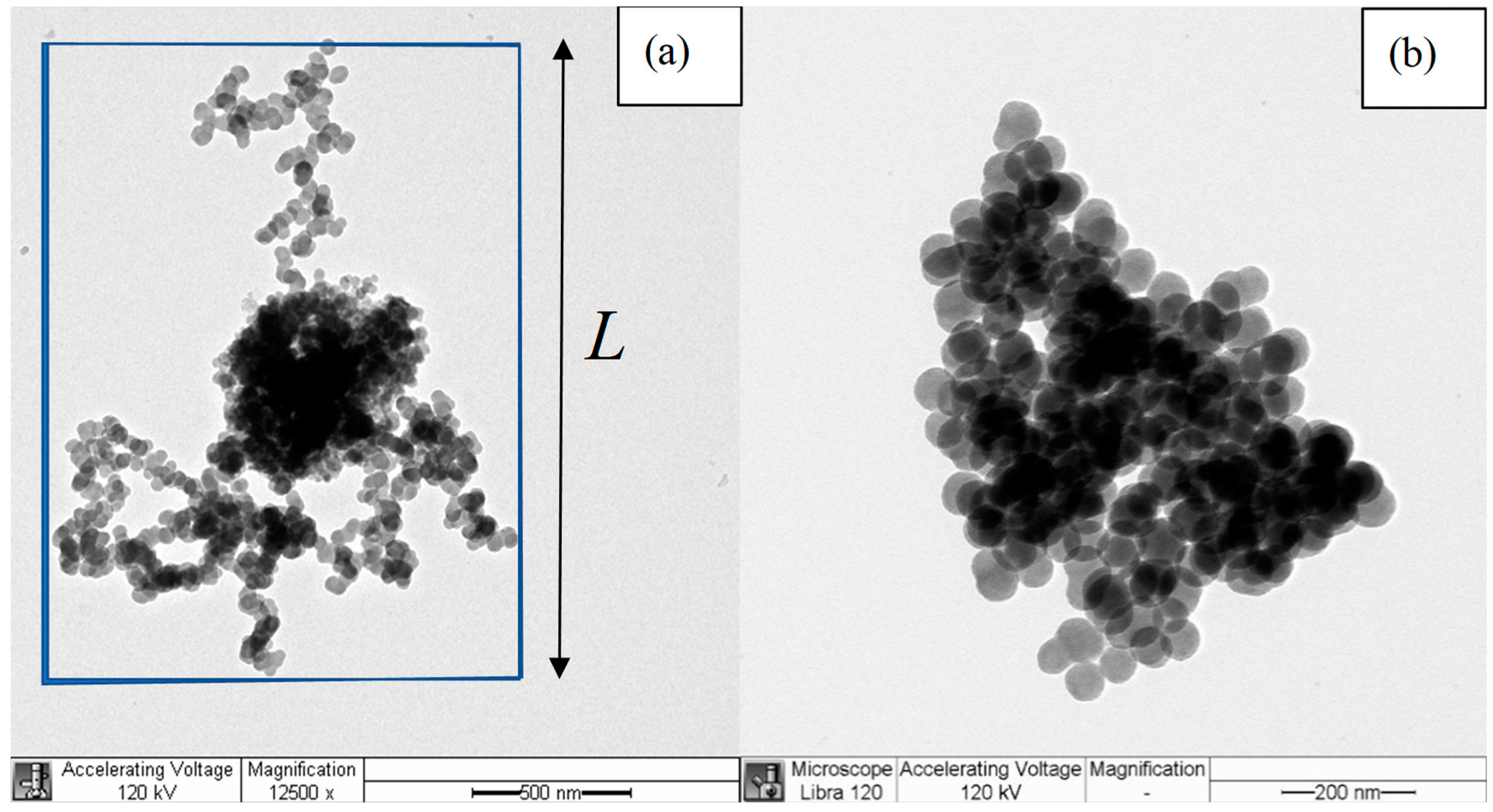
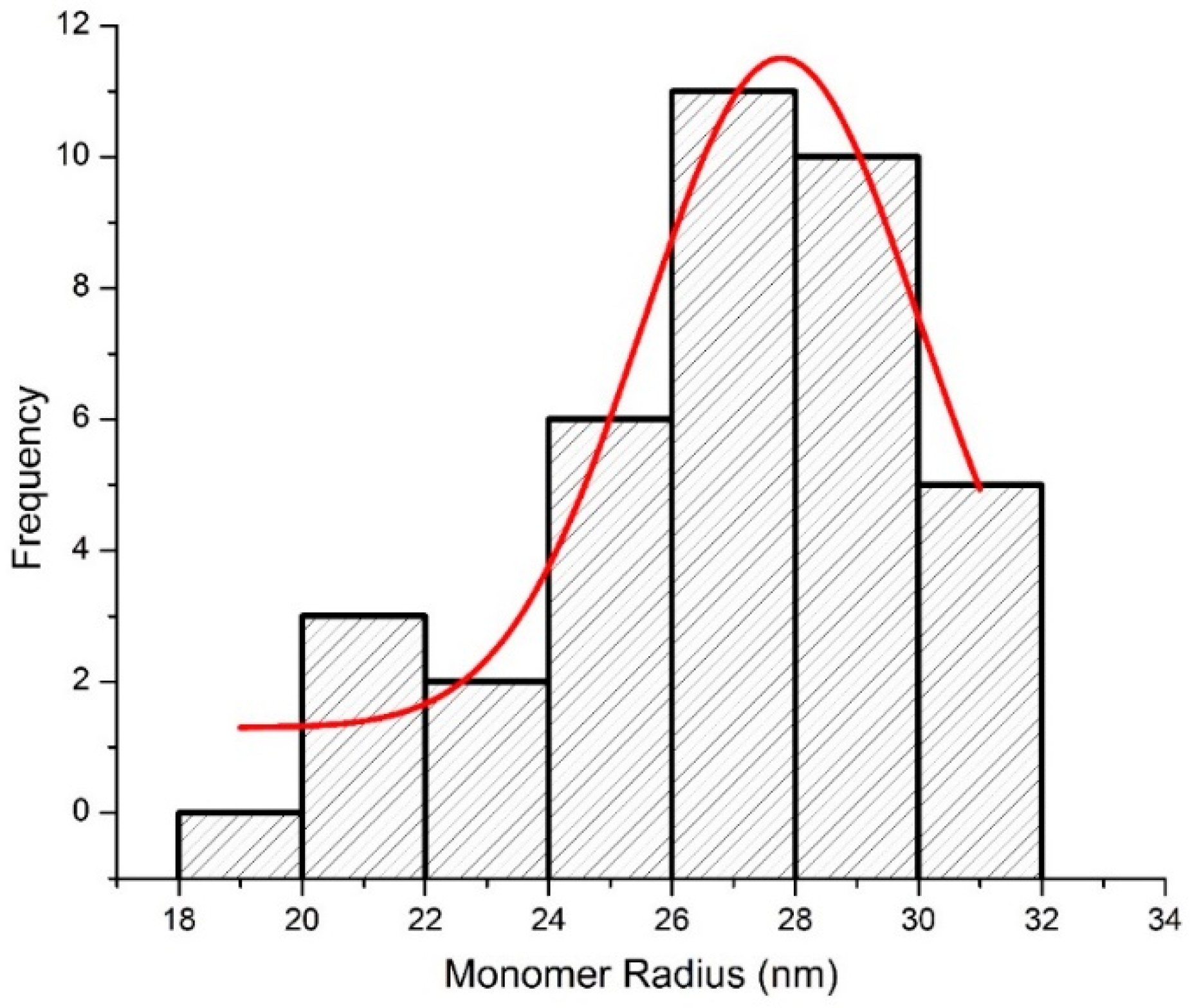

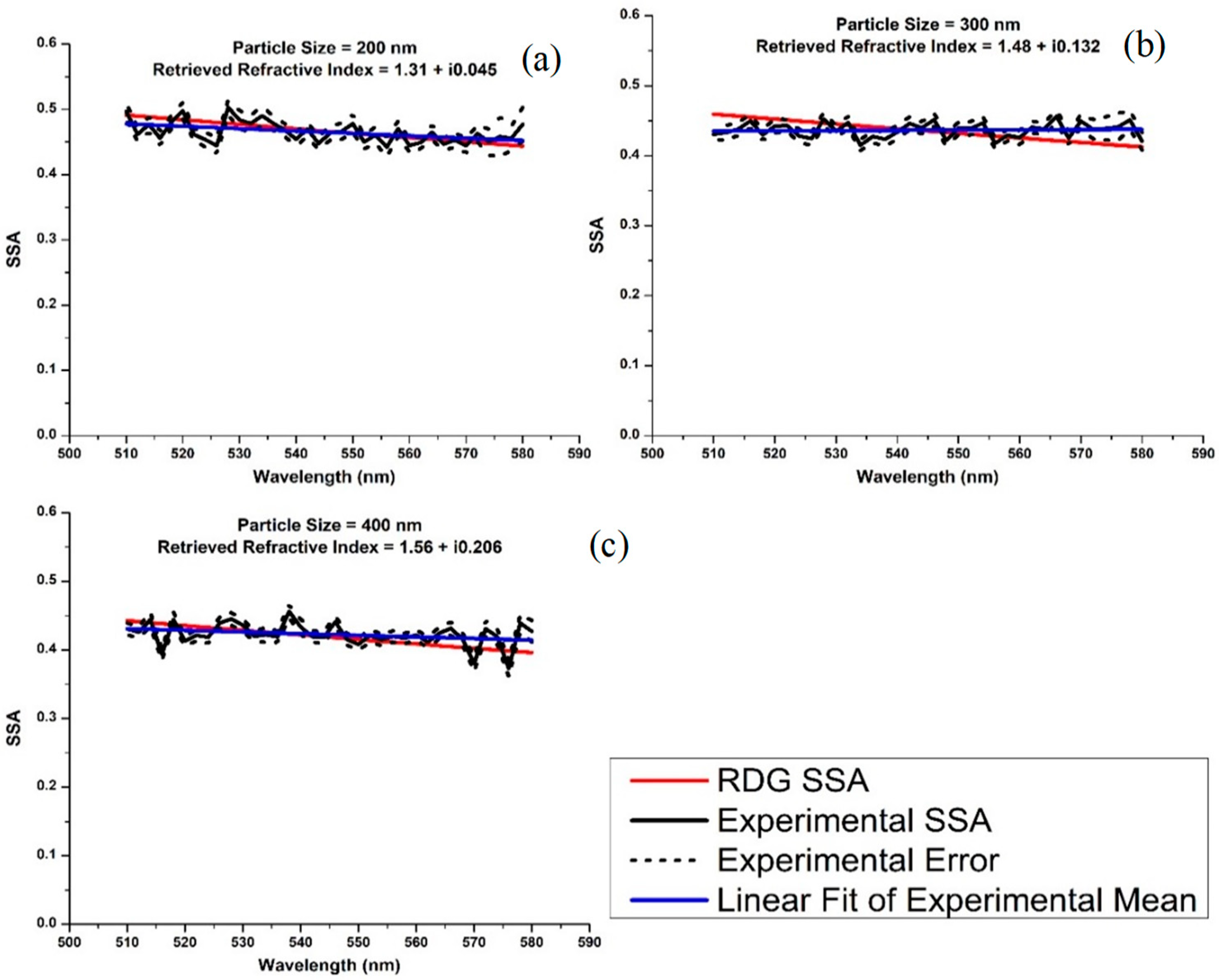
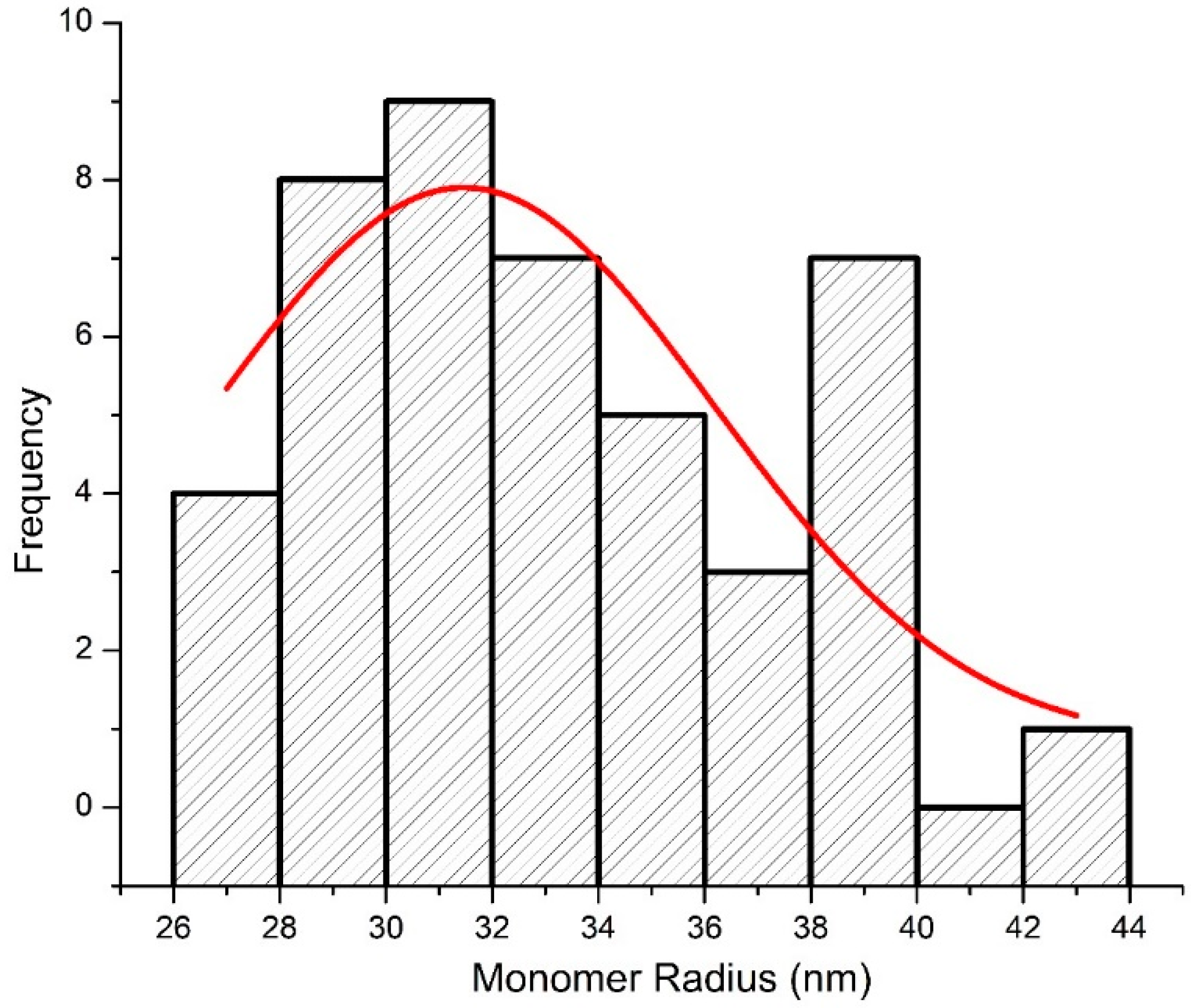
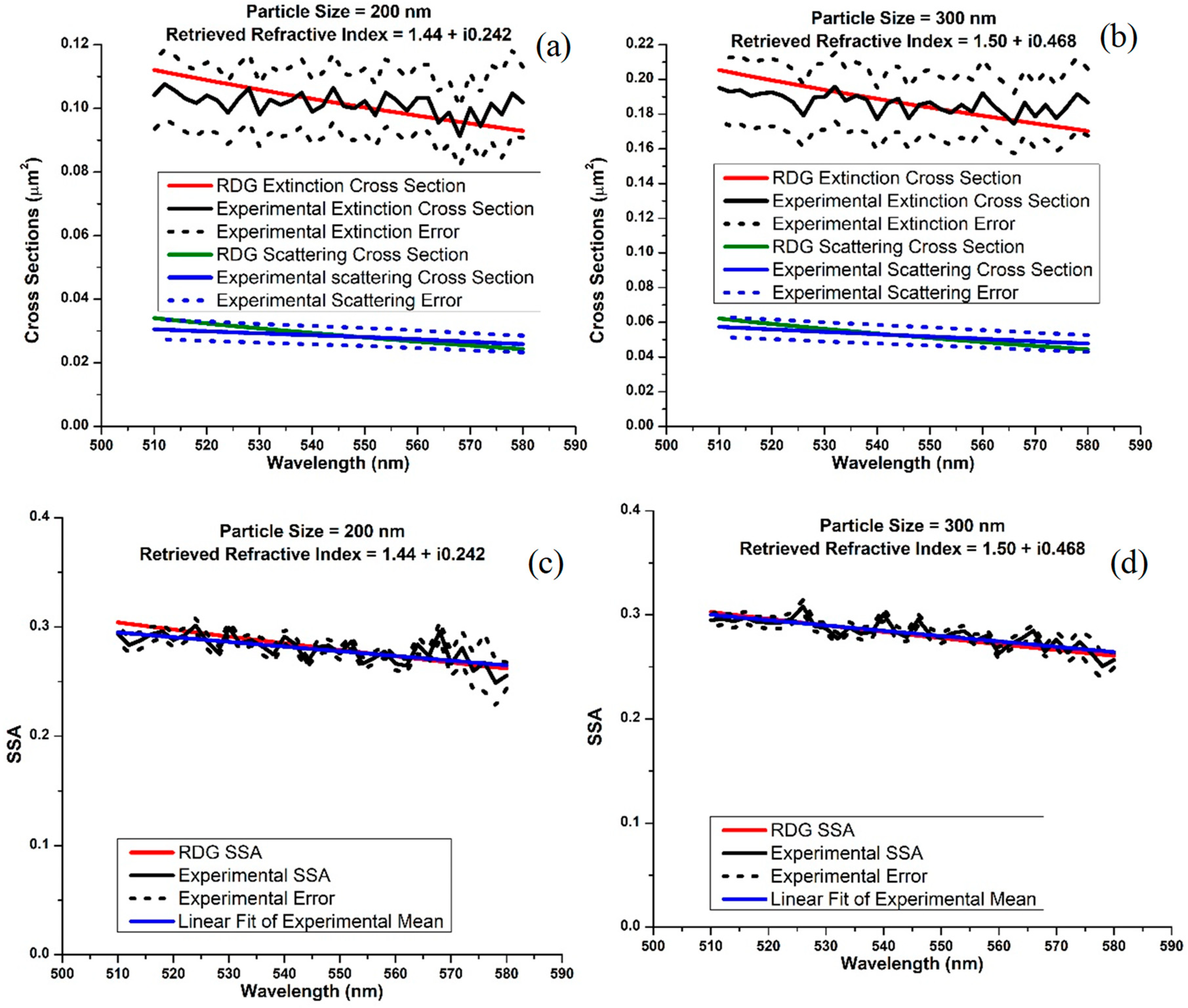
| Fuel | No. of Particles Analyzed | a (nm) | L (nm) | Rg (nm) | Np |
|---|---|---|---|---|---|
| Eucalyptus | 37 | 27.8 | 1972.9 | 657.6 | 654 |
| Olive | 43 | 31.5 | 902.2 | 300.7 | 128 |
| Particle Size (nm) | RDG Mean SSA | Measured Mean SSA | Retrieved Refractive Index |
|---|---|---|---|
| 200 | 0.47 ± 0.01 | 0.46 ± 0.02 | 1.31 + i0.045 |
| 300 | 0.44 ± 0.01 | 0.44 ± 0.01 | 1.48 + i0.132 |
| 400 | 0.42 ± 0.01 | 0.42 ± 0.02 | 1.56 + i0.206 |
| Particle Size (nm) | RDG Mean SSA | Measured Mean SSA | Retrieved Refractive Index |
|---|---|---|---|
| 200 | 0.28 ± 0.01 | 0.28 ± 0.01 | 1.44 + i0.242 |
| 300 | 0.28 ± 0.01 | 0.28 ± 0.01 | 1.50 + i0.468 |
© 2020 by the authors. Licensee MDPI, Basel, Switzerland. This article is an open access article distributed under the terms and conditions of the Creative Commons Attribution (CC BY) license (http://creativecommons.org/licenses/by/4.0/).
Share and Cite
Sarpong, E.; Smith, D.; Pokhrel, R.; Fiddler, M.N.; Bililign, S. Refractive Indices of Biomass Burning Aerosols Obtained from African Biomass Fuels Using RDG Approximation. Atmosphere 2020, 11, 62. https://doi.org/10.3390/atmos11010062
Sarpong E, Smith D, Pokhrel R, Fiddler MN, Bililign S. Refractive Indices of Biomass Burning Aerosols Obtained from African Biomass Fuels Using RDG Approximation. Atmosphere. 2020; 11(1):62. https://doi.org/10.3390/atmos11010062
Chicago/Turabian StyleSarpong, Emmanuel, Damon Smith, Rudra Pokhrel, Marc N. Fiddler, and Solomon Bililign. 2020. "Refractive Indices of Biomass Burning Aerosols Obtained from African Biomass Fuels Using RDG Approximation" Atmosphere 11, no. 1: 62. https://doi.org/10.3390/atmos11010062
APA StyleSarpong, E., Smith, D., Pokhrel, R., Fiddler, M. N., & Bililign, S. (2020). Refractive Indices of Biomass Burning Aerosols Obtained from African Biomass Fuels Using RDG Approximation. Atmosphere, 11(1), 62. https://doi.org/10.3390/atmos11010062






